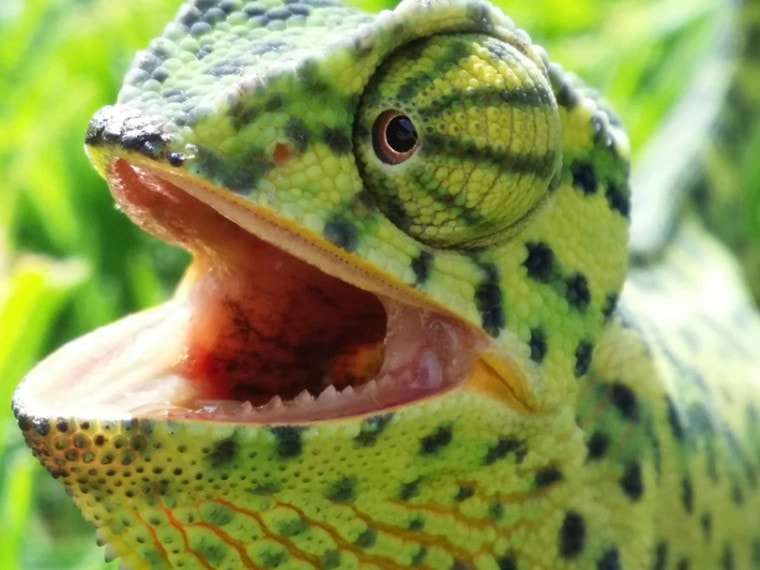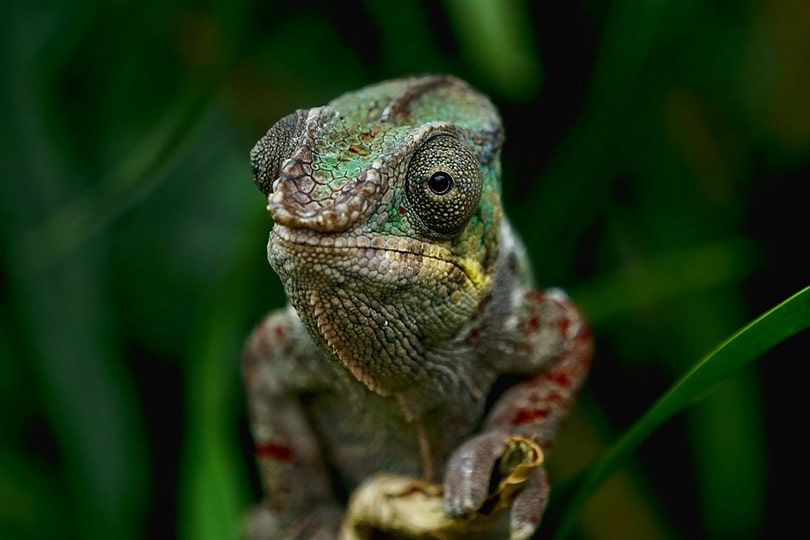
In the reptile world, chameleons steal the show with their futuristic look. The iridescent cells of their skin give them colors that change according to their mood swings; their sticky tongues allow them to catch wriggling prey; their eyes are completely independent, being able to go in opposite directions simultaneously. All these attributes make this little reptile a strange but also charismatic animal. And what about its teeth? Does the chameleon have any? What are they used for?
The short and sweet answer is yes, chameleons do have teeth. These reptiles possess an acrodont dentition, which means their teeth sit vertically on the jawbone. They are triangular and are used to hold prey rather than chew it.
Unlike mammals, there is no separation between the tooth socket and the tooth therein. Chameleon teeth are not naturally modified and cannot fall out: they stay in place for life.
Chameleons: A Quick Overview
For starters, a chameleon is not a single species but a family of lizards called Chamaeleonidae. There is, therefore, a multitude of chameleon species, such as the veiled chameleon (Chamaeleo calyptratus) or the horned chameleon (Trioceros jacksonii willegensis), among the most common species kept in captivity.
Despite exceptions with some species that live in desert environments, chameleons are a family of arboreal reptiles native to tropical climates.
They eat an insectivorous, fruit-prone diet, which means they feed primarily on insects and supplement their vitamin requirements with fruit.
They are also diurnal animals: since their eyes do not allow night vision, they avoid moving at night.

What Kind of Teeth Do Chameleons Have?
Chameleons have small conical teeth, all identical and rudimentary, inserted directly on the upper edge of the jawbone: this is called acrodont dentition. This dentition is different from reptiles whose teeth are fixed on the inner edge of the bone (pleurodont) or in cavities (thecodont). Teeth are therefore not replaced in the chameleon, unlike most other lizards. Besides, the periodontal tissue of these types of teeth is more fragile; therefore, chameleons are more prone to bacterial and fungal infections.
Commonly kept species of lizards with acrodont dentition include bearded dragons (Pogona vitticeps), Asian water dragons (Physignathus concinnus), Australian water dragons (Physignathus lesueurii), and frilled dragons (Chlamydosaurus kingii).
The inside of the oral cavity is often colored (red, pink, purple, or yellow); this serves mainly as a defense mechanism. Indeed, when threatened, some chameleons show off the inside of their mouths to scare away their opponents. The mouth also contains glands that secrete mucus and glands that produce non-sticky saliva.
In addition, the tip of the chameleon’s tongue is covered with numerous epithelial glands and papillae that adhere to irregularities on the prey’s surface, like sticky hooks.

What Are the Other Surprising Physical Attributes of the Chameleon?
The chameleon has many other astonishing physical attributes that make it such a fascinating animal.
First off, it has large protruding eyes, each of which can move independently of each other so that it can scan for any prey or threat around it.
To complete this panoramic view, the chameleon has an additional asset: its skin. These animals are indeed famous for having the possibility of camouflaging themselves in their environment by taking the color of the objects surrounding them. However, despite these strongly held beliefs, the chameleon does not change color to follow the rules of mimicry; instead, it changes color depending on its emotions, certain amounts of light, or even variations in its thermal environment.
Plus, to move around, the chameleon has four clawed legs that allow it to have an exceptional grip on trees, as well as a tail that can unfold and which it uses to grab the branches around it.
Finally, the chameleon has another unique attribute: its tongue. A length that can be up to twice its size, capable of lifting up to a third of its weight, able to reach a speed of 60 miles per hour (mph) in a hundredth of a second, and possessing mucus on the tip which will prevent any of its prey from escaping; all these attributes make the chameleon a peerless creature.
Related reads:
- Do Chameleons Have Ears? Can They Hear You?
- Veiled Chameleon Info: Pictures, Characteristics & Facts
Final Thoughts
In short, chameleons do have teeth, but their acrodont dentition differs from that of mammals and other reptiles. They mainly use their teeth to hold their prey in place rather than chewing it. They also have many other physical attributes, which make them as enjoyable to study as they’re to observe.
Featured Image Credit: André Pretorius, Pixabay









